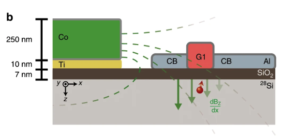A team of engineers from the University of New South Wales, Australia recently found a new way to create more stable quantum chips. It is done by increasing the stability of artificially produced atoms over silicon chips. This results in the production of more consistent quantum qubits or bits.

A cross-sectional schematic of the device, fabricated on a purified Silicon-28 epi-layer (800 ppm). Read the full article and see related images here.
The new research takes roots in previous work of this team. In the first part, they created the first qubits on silicon chips that could process information with 99 percent precision. But the rate of errors could not be reduced due to silicon imperfections. However, now they have a solution.
In a natural atom, all electrons spin in three dimensions around a nucleus. These three-dimensional segments are called orbits or electron shells, all elements have different electron shells depending on the number of electrons they have.
Artificial atoms or quantum dots are nanoscale semiconducting crystals with extra space. This space traps and restricts the movement of electrons in three dimensions. Therefore, electrons are held in a place with electric fields. These atoms were created with a metal surface gate electrode that applies voltage to silicon. All extra electrons are allured from silicon to the quantum by removing silicon imperfections.
Elements such as sodium, lithium, and hydrogen have a single electron in their outer most shell. Normally, these elements are used as quantum computing models. Creation of artificial atoms with a single electron allowed engineers to use these as a qubit, the quantum doppelganger of a binary bit.
Unlike the binary bits, the quantum bits are either in state 1 or 0 or both simultaneously. It means the qubits can take care of parallel computations, unlike the binary bits that computed problems in a consecutive manner. This makes qubits an extremely powerful computing tool. Previously, the system was flawed. The team made it better by turning up the voltage on the gate electrode, drawing in more electrons. This means the electrons are able to imitate heavier atom electrons with various orbits. The artificial electron shells are as well-organized and predictable as in natural atoms.
Quantum engineer, Andrew Dzurak from the University of New South Wales, Australia, says, “What really excites us about our latest research is that artificial atoms with a higher number of electrons turn out to be much more robust qubits than previously thought possible, meaning they can be reliably used for calculations in quantum computers.”
Filed Under: Components, News


Questions related to this article?
👉Ask and discuss on EDAboard.com and Electro-Tech-Online.com forums.
Tell Us What You Think!!
You must be logged in to post a comment.